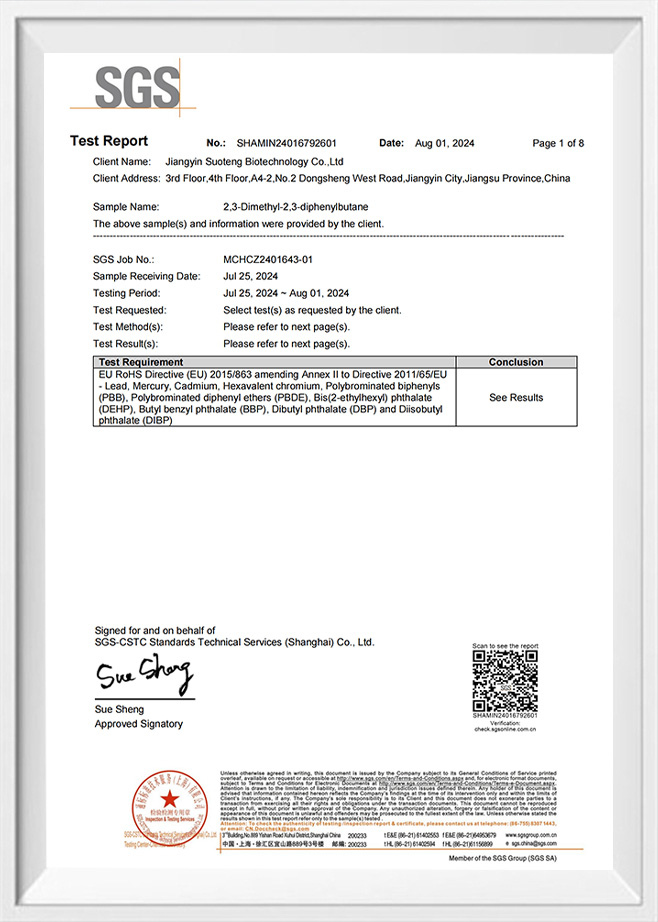A Comprehensive Guide to organic peroxides series applications
READ MORE
General All-Purpose Plastics Manufacturers
General-purpose plastic is a common plastic product that is commonly used in a variety of different applications. They are made of polymers and generally have good toughness, wear resistance, and chemical stability. This plastic is widely used in the manufacture of various daily necessities, industrial parts and packaging materials.
information to be updated
-
Organic Synthesis Field
-
Agriculture Field
-
Fuels And Coatings Industry
-
Transportation
-
Electronic Andelectrical Equipment
-
Textile Fabrics
-
Hair Care Products
-
Makeup Products
-
Skin Care Products
-

Quality
-

Customization
-

Cost
-

Capacity
-

Service
-
We have our own testing lab and the advanced and complete inspection equipment, which can ensure the quality of the products.
-
We have a strong R&D team, we can customize and produce products according to the customers' requirements.
-
We own three factories of our own. So we can provide preferential prices and good products directly.
-
Our annual production capacity is over 20000 tons, we can meet the needs of different customers with different purchase quantities.
-
We focus on developing high-quality products for top-end markets. Our products are in line with international standards, and are mainly exported to European, American, and Asian countries.
-
0+
Annual Output
-
0+
Global Cooperative Customers
-
0+
Technical Staff
-
0+m²
Advanced Factory
-
-
Introduction: Navigating the Complex World of Daily Chemicals Daily Chemical The term Daily Chemi...
READ MORE -
As the global cosmetics and personal care market continues shifting toward safer, high-purity, and e...
READ MORE -
.intro-container { display: flex; align-items: center; gap: 20px; margin: 20px 0; }...
READ MORE -
An Organic Peroxides Series is a molecular compound that is formed during the multi-step synthesis o...
READ MORE
Versatile Applications and Enhancements of General-Purpose Plastics: EPS, GPPS, and Antistatic Agents
General-purpose plastics are a category of polymers known for their versatility and wide range of applications. These plastics are characterized by their ease of processing, affordability, and balance of physical properties, making them suitable for a broad spectrum of uses. Two commonly known general-purpose plastics are Expandable Polystyrene (EPS) and General Polystyrene (GPPS).
Expandable Polystyrene (EPS)
Properties and Structure: EPS is a lightweight, rigid, and closed-cell foam material. It is composed of individual cells of low-density polystyrene. These cells contain a small amount of pentane gas, which causes the material to expand when subjected to steam.
Manufacturing Process: The production of EPS involves the pre-expansion of polystyrene beads, which are then molded into various shapes and sizes. The pre-expanded beads are aged, allowing them to stabilize and reach equilibrium. Finally, they are placed into molds where steam is applied, causing the beads to expand and fuse together to form a solid structure.
Applications: EPS is widely used for packaging due to its excellent cushioning properties. It is also used in building and construction as insulation material, offering thermal and acoustic insulation. Additionally, EPS finds applications in the production of lightweight and durable items such as surfboards, coolers, and display materials.
Advantages: EPS is valued for its excellent insulation properties, lightweight nature, moisture resistance, and cost-effectiveness. It is also recyclable, which helps reduce its environmental impact.
General Polystyrene (GPPS)
Properties and Structure: GPPS is a transparent, rigid thermoplastic with a relatively high melting point. It is known for its clarity, making it ideal for applications requiring visual transparency. The polymer structure consists of a long chain of styrene monomers.
Manufacturing Process: GPPS is produced through the polymerization of styrene monomers. This can be achieved through several methods, including bulk, solution, suspension, and emulsion polymerization. The process results in a clear and brittle plastic that can be further processed into various products through methods such as injection molding and extrusion.
Applications: GPPS is commonly used in the production of consumer goods, such as disposable cutlery, CD cases, and plastic models. It is also employed in the manufacturing of laboratory ware, light diffusers, and various types of packaging.
Advantages: GPPS offers high clarity, ease of processing, and good dimensional stability. It is also relatively inexpensive, making it a cost-effective material for many applications.
Antistatic Agents
Purpose and Importance: Antistatic agents are additives used in plastics to reduce or eliminate static electricity buildup. Static electricity can cause dust and dirt attraction, create handling problems, and even pose risks of ignition in certain environments.
Types and Mechanisms: Antistatic agents can be either external or internal. External antistatic agents are applied to the surface of the plastic, forming a conductive layer that dissipates static charges. Internal antistatic agents are incorporated into the plastic during manufacturing, migrating to the surface to provide long-term antistatic properties. Common antistatic agents include quaternary ammonium compounds, fatty acid esters, and ethoxylated amines.
Applications: Antistatic agents are used in a variety of industries, including electronics, packaging, textiles, and automotive. They are essential for products such as electronic device housings, cleanroom supplies, plastic films, and automotive components.


 English
English 中文简体
中文简体


























